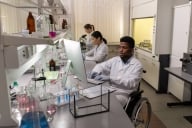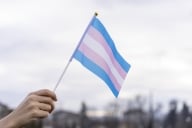You have /5 articles left.
Sign up for a free account or log in.
Life on the tenure track as an African American female professor of physics and astronomy, a wife, and a mother of our now 3-year-old daughter has been, in a word, busy. I’ve been publishing papers, applying for grants, teaching and mentoring students, and being of service to my department, the larger astronomy community, middle school girls of color and the general public. I’ve flailed and flown in my eternal quest to be a good mom and partner -- the kind of person to these two loves of my life who can look in the mirror when the dust settles at the end of the tenure track and like what she sees.
My decisions about what to share and when on my tenure-track journey have often been strategic. My priority as a faculty member has been getting tenure, and regardless of all that I had accomplished, I was keenly aware of how political, and even subjective, the votes on my case by colleagues in closed-door faculty meetings could be. That reality guided my decisions about when it made sense to speak out -- and when it made better sense to keep quiet.
To my knowledge, I haven’t been the victim of many overt racist comments while on the tenure track at my institution. But I have experienced racist verbal judgments nearby, like the time I was walking through our neighborhood south of the campus with my mixed-race infant daughter. (My husband is white, and I am Black.) A middle-aged white woman walking her dog stopped, came over to our stroller and exclaimed at my daughter’s beauty, specifically mentioning her piercing blue eyes. Then, still gazing at my daughter, she said, almost under her breath, “Is she yours?”
I’ve become keenly aware of the narrow lens through which many people view, process and interpret the world containing my daughter and me. The applications of this narrow worldview, from which assumptions are made and conclusions drawn, have the potential to be far-reaching, whether on a university campus or not.
It might have been easier if that woman’s comment had flown by me undetected. Being oblivious to racism and hostility can be, as Jarita Holbrook proposed years ago in her paper “Survival Strategies for African American Astronomers and Astrophysicists,” an effective survival skill for African American astronomers aching to remain afloat mentally, emotionally and physically in a field dominated by white men.
But there is a cost to remaining publicly silent in the face of overtly racist and/or exclusionary attitudes. I have felt the emotional toll in my body, tightening my chest and forming an avocado-sized lump in my gut. These feelings emerged in faculty meetings when the discussions turned to the practice of discouraging students with low grades from pursuing careers in physics. I wanted to challenge what I perceive to be a fixed mind-set with a (preferred) growth one, where intelligence and ability are not static but rather grow and develop in response to challenge and adversity. I wanted to alert other faculty to the systemic racism that runs through the veins of academia. I wanted to tell those professors that, from their high perches in the ivory tower, they have a distorted view, a far too narrow set of criteria for “potential.”
That narrow worldview, and the actions that emerge from it, consciously and unconsciously exclude groups of people from the sciences. Though no one in the faculty meetings explicitly mentioned the demographic makeup of the students discouraged from continuing in physics, what I know about the demographic makeup of my field tells me that they were disproportionately from groups of racial minorities, specifically Black people.
Although 13.4 percent of the population of the United States is African American or Black, Black people do not currently occupy an equally representative percentage within the fields of physics and astronomy, and that trend persists across all levels of the academic hierarchy. To take physics as an example: in 2018, African Americans earned just 3 percent of the physics bachelor’s degrees in the United States -- a smaller percentage than that in 1994 (just over 4 percent). Similarly, during the 2016-17 academic year, of the 1,862 total doctorates earned in physics, fewer than 16 were earned by African Americans.
In astronomy, the number of Latinx women earning bachelor’s degrees has doubled to 16 percent since 2002, and though it is still under the Hispanic/Latino population of 18.5 percent in the United States, it is coming demonstrably closer to that representative percentage. In contrast, the number of African American women earning astronomy bachelor’s degrees has remained relatively static over the same time period, at 3 percent.
I’ve wanted to alert fellow faculty members to stereotype threat, a phenomenon supported by well-documented, empirical evidence. Additionally, we cannot talk about helping women (which usually means white women) and helping Black people in the same breath and with the same set of tools. Each group is susceptible to different forms of stereotype threat, and each must be understood separately, with dedication and a firm commitment to the care of that particular group’s specific needs.
I have wanted to tell all physics and astronomy faculty from nonmarginalized groups how much historical baggage a Black student may bring with them in their mind and heart when they enter an exam room -- baggage that doesn’t accompany a white student, especially a white man. Of what, exactly, might this baggage be composed? Perhaps the weight of centuries of Black people being “put in their place,” of being told that the fields of physics and astronomy aren’t for them, of receiving a look of surprise when a white person finds out that they are in fact in these fields. To know that the country of their birth, their home, was built and nurtured and fought for on the backs of their ancestors. That a Black student might be studying next to the descendant of someone who fought for the freedom to call their ancestor his slave, like my great-great-great-grandma Cole.
A Black undergraduate student brings not only a head filled with equations and relationships and Kepler’s laws and Bernoulli’s principle and the understanding of how to solve multibody force problems. The bodies of Black students contort under the weight of multiple forces. Those forces rarely enter into the equation that professors use to calculate a Black student’s potential for success in physics. Yet if professors included a sum of those forces into that equation, they would recognize a fundamental truth: a Black student who has carried this lineage of centuries of oppression, subjugation and suspicion, along with their own personal legacy of continual underestimation of their potential, and has still managed to make it this far -- to the same point as their white counterparts who did not have to surmount such obstacles -- can damn sure do anything they set their minds to.
Newly tenured, I finally spoke up in a faculty meeting. But I lied. In a follow-up essay, I’ll tell you why.




